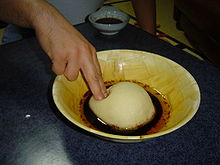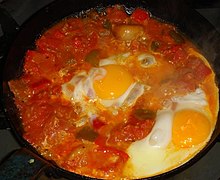Food
Tunisian Food features cooking traditions, ingredients, recipes and techniques developed in Tunisia since ancient times. Tunisian cuisine has influenced many cultures and nations like Italians, Andalusians, French and Arabs.
Like many countries in the Mediterranean basin, the Tunisian cuisine is heavily based on olive oil, spices, tomatoes, seafood and meat. Yet, it has a distinctive spiciness that differs it from food in nearby countries.
Unlike other North African cuisines, Tunisian food is quite spicy. A popular condiment and ingredient which is used extensively in Tunisian cooking, harissa, is a mix of ground chili peppers, garlic, and caraway or spices commonly sold together as a paste. It is usually the most important ingredient in different sauces and gravies. Western harissa mostly contains red chilies to replace black cumin, which is different from standard cumin.
Other common spices include cumin or cumin seeds, garlic, caraway seeds, coriander seeds and paprika. A recipe for the sauce includes red chili peppers and garlic, flavored with coriander, cumin, olive oil and often tomatoes.
Like harissa or chili peppers, tomato paste is also an important ingredient in the cuisine of Tunisia. Tuna, eggs, olives and various varieties of pasta, cereals, herbs and spices are also ingredients which are prominently used in Tunisian cooking.
Potatoes were introduced by European settlers in the early 20th century and have become a common ingredient in traditional salads, sauces and couscous. By 1990 one of the most common homemade foods with potatoes was French fries.
Tunisian ingredients include the following:
- Condiments and flavorings: harissa, rose water, orange blossom water, jasmine water and geranium water.
- Eggs.
- Farm animals: lamb, veal, beef, camel and chicken.
- Fish and seafood: tuna, squid (calamari), octopus, anchovies, eel, sardines, mackerel, red snapper, sea bream, sea snails and sea bass.
- Fruits: lemon, oranges, figs, dates, olives, apricots, pomegranates and quince.
- Herbs: parsley, coriander, mint, basil, rosemary, oregano, bay leaves and thyme.
- Nuts: hazelnuts, almonds, chestnuts, pine nuts and peanuts.
- Spices: garlic, anise, saffron, cinnamon, caraway, coriander, cumin, fennel, fenugreek, ginger, white pepper, black pepper, red pepper and cloves.
- Vegetables: onions, bell peppers, carrots, chickpeas, tomatoes, capers, celery, turnips, potatoes, chili peppers (Baklouti peppers), cucumbers and eggplants.
- Other popular ingredients: honey.
Tunisians also produce grapes, wheat, barley and orchard fruits. They use these to make wines, beers, and other alcohol drinks. Scented waters with dark rose or blossom petals have been called "scents from heaven".
Tabil, pronounced "tebel," is a word in Tunisian Arabic meaning "seasoning" (similar to adobo in Spanish) and now refers to a particular Tunisian spice mix, although earlier it only meant ground coriander. Organs from animals are also used in Tunisian cooking, such as lamb brains, beef liver and fish heads.
Due to the long coastline and fishing ports, seafood is important in Tunisian cuisine. Fish can be grilled, baked, fried, or stuffed and seasoned with cumin (kamoun). Squid, cuttlefish and octopus are served in hot crispy batter with slices of lemon, in a cooked salad, or stuffed and served with couscous.
Snails have been eaten in Tunisia since prehistoric times.
Today, snails are still enjoyed in several regions, such as Hammamet, the central coast (Sahel) and Kairouan, but disliked in others.




Comments
Post a Comment